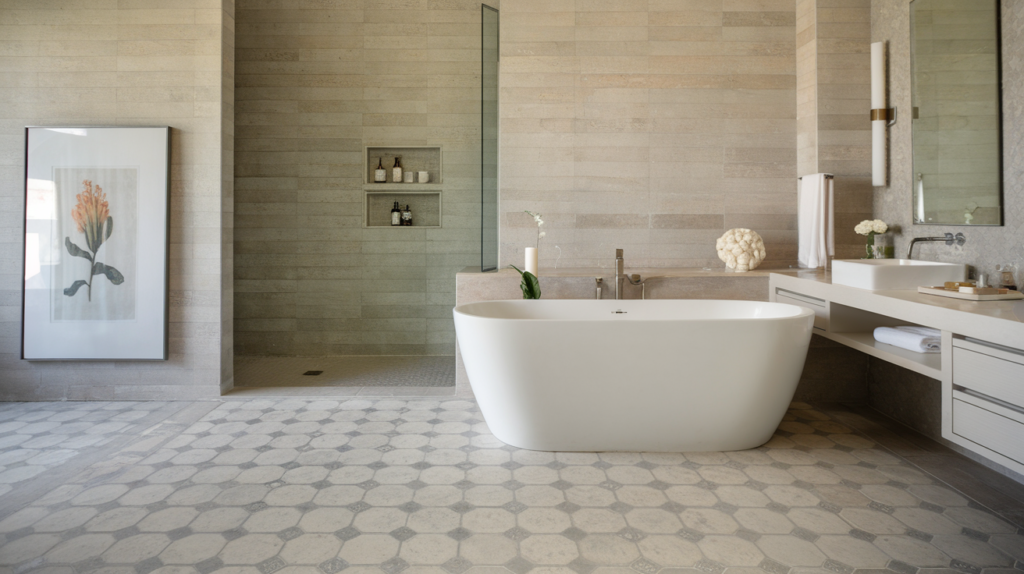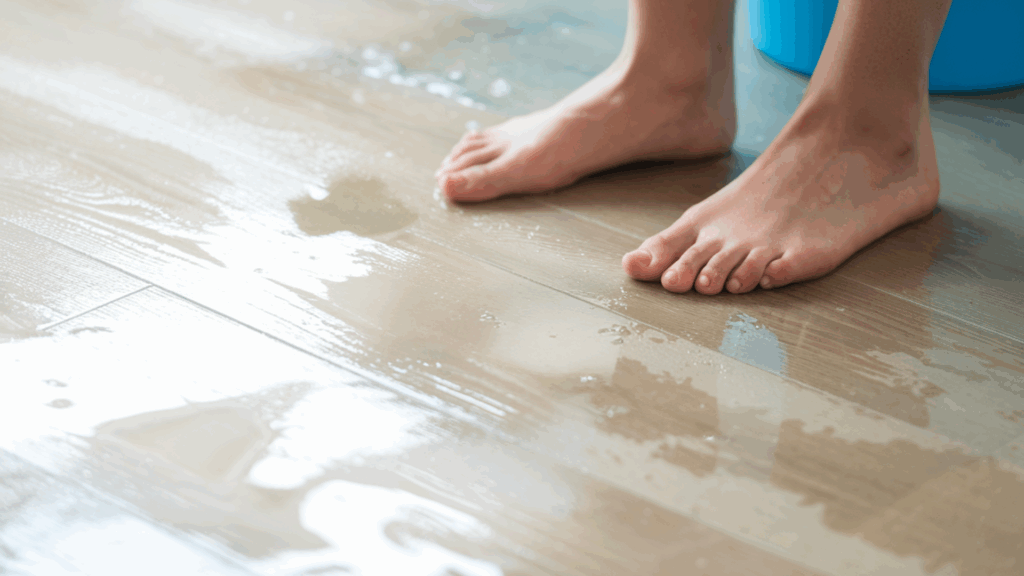Porcelain tile is a popular choice for many homeowners, but I’ve often wondered myself if it’s slippery when wet.
I’ve had a few close calls in my own bathroom, where a small spill left me second-guessing my choice of flooring. If you’ve been curious about the same thing, you’re not alone.
Many people have concerns about how safe porcelain tile really is in wet conditions.
In this blog, you’ll learn just how slip-resistant porcelain tiles can be, particularly when they’re exposed to water or moisture.
I’ll break down the factors that contribute to their slipperiness, such as the tile finish and texture, and offer practical tips for improving safety.
By the end, you’ll have a clear idea of how to keep your floors looking great while staying safe. Let’s get started!
Understanding Porcelain Tile and Its Characteristics
Porcelain tile is a type of ceramic tile made from a dense clay material that is fired at a high temperature.
This makes it stronger and more durable than many other types of flooring. It’s commonly used in areas like bathrooms, kitchens, and entryways because it’s easy to clean and maintain.
Porcelain tiles are known for their low porosity, which means they don’t absorb water easily, making them ideal for wet areas.
They’re also highly durable, resistant to scratches, and can last for many years with proper care. While porcelain tiles are a type of ceramic tile, they differ in a few key ways.
Porcelain is denser and less porous than regular ceramic, making it more water-resistant and harder.
This gives porcelain an edge in places where moisture is common, like showers or kitchen floors. Knowing these qualities will help you make the right choice for your home.
Is Porcelain Tile Naturally Slippery when Wet?

Porcelain tiles can be slippery when wet, especially with a glossy or polished finish.
While porcelain is water-resistant, a smooth surface can trap water, making it easier to slip.
Bathrooms and kitchens are common areas where this happens after spills or when the floor gets wet.
Polished porcelain tiles tend to be more slippery than matte or textured ones, which offer better traction.
If slipperiness is a concern, opt for tiles with a matte or textured finish for added safety.
Understanding these differences will help you choose the right tiles for your space and reduce slip risks.
Factors Influencing Slip Resistance
By understanding these factors, you can make an informed decision about the best porcelain tiles for your home. Let’s take a closer look at some of the most important factors that influence tile slip resistance.
1. Surface Texture and Finish
The surface texture and finish of your porcelain tiles play a big role in how slippery they are, especially when wet.
Tiles with this finish tend to be smoother and can get very slippery when water is present. On the other hand, matte or textured finishes provide more grip, making them safer to walk on when wet.
If slip resistance is important in your space, such as in bathrooms or kitchens, consider going for tiles with a rougher or more textured surface.
These finishes help reduce the risk of slips by offering better traction.
2. Coefficient of Friction (COF)
The coefficient of friction (COF) is a term used to measure how much friction a surface provides. A higher COF means more friction, which leads to better grip and less likelihood of slipping.
For porcelain tiles, the COF will depend on the texture and finish of the tile. Tiles with a higher COF are less slippery, even when wet.
If you want to choose safer tiles, look for options with a higher COF rating, especially for areas that get wet often.
3. Environmental Factors
Environmental factors can also affect the slip resistance of porcelain tiles. For example, water temperature plays a role; cold water can make tiles feel slicker than warm water.
Additionally, contamination from substances like soap, grease, or cleaning products can create a slippery layer on the surface of the tiles.
The angle of the floor is another factor; floors that are angled or sloped can cause water to pool in certain areas, making those spots more slippery.
Being mindful of these factors can help you maintain a safer floor and reduce slip risks.
4. Tile Size and Grout Lines
The size of the tiles and the grout lines between them can also influence slip resistance.
Larger tiles typically have fewer grout lines, which means there’s less opportunity for water to pool in the grooves, making them less slippery.
Smaller tiles, however, often have more grout lines, and water can collect in these spaces, making the floor more slippery. Grout lines with a rough texture can also add some traction, helping reduce the risk of slipping.
Consider the tile size and how the grout is applied when choosing porcelain tiles for wet areas.
5. Floor Slope and Drainage
The slope and drainage of the floor play a critical role in keeping your porcelain tiles from becoming too slippery.
Floors with poor drainage or inadequate slope can trap water, creating slick spots.
If you’re installing tiles in areas prone to wetness, like a shower or outdoor patio, ensure that the floor is sloped correctly to allow water to flow away from the surface.
Proper drainage helps keep the water from sitting on the tiles, which can reduce slipperiness and increase safety.
Ways to Increase Slip Resistance on Porcelain Tiles
If you’re concerned about the slipperiness of your porcelain tiles, there are several ways to make them safer without replacing them entirely.
1. Choosing Textured or Matte Tiles
One of the easiest ways to enhance slip resistance is by choosing textured or matte tiles.
These finishes provide better traction compared to polished tiles. Textured tiles have a rougher surface that grips your feet, even when the tiles are wet.
Matte finishes also help by offering more friction, making them a safer choice for wet areas like bathrooms, kitchens, and entryways.
If you’re planning to install new tiles, go for these finishes to reduce the chances of slipping.
2. Anti-Slip Coatings
If you already have porcelain tiles and don’t want to replace them, there are anti-slip coatings you can apply.
These treatments are designed to improve the traction of the tile without changing its appearance.
The coatings work by adding a textured layer to the tile’s surface, increasing friction and reducing slipperiness.
You can find these treatments in home improvement stores or have a professional apply them for you. This is an effective solution if you’re looking to make your current porcelain tiles safer.
3. Regular Maintenance
Keeping your porcelain tiles clean is essential for preventing slip hazards. Avoid soapy residues, as soap can leave a slick film on the surface of the tiles.
Always wipe up spills as soon as they happen to prevent water or liquids from sitting on the tiles for too long.
Use a mild cleaner and a soft mop to avoid scratching the tile surface. Regular cleaning will help maintain the tile’s traction and ensure that water or other substances don’t make the floor slippery.
Taking these steps can significantly reduce the risk of slipping.
Safety Tips for Homeowners
When it comes to keeping your home safe, small changes can make a big difference. These are a few safety tips that can help you reduce the risk and keep your floors safe.
- Use Rugs or Mats in High-Traffic Areas: Place non-slip rugs or mats in areas like bathrooms, kitchens, and entryways, where water can easily spill. This will help absorb moisture and provide additional grip.
- Keep Floors Dry: Always wipe up spills as soon as they happen. Wet floors are a major cause of slips, so the quicker you clean them, the safer your home will be.
- Install Slip-Resistant Pads: If you have large porcelain tiles, consider adding slip-resistant pads or underlays to improve traction, especially in wet areas.
- Check Floor Angles: Make sure your floors are properly sloped to encourage water drainage. This helps prevent puddles that could make the tiles slippery.
- Educate Family Members: Remind everyone in your household, especially kids and seniors, to be cautious when walking on wet floors. It’s important that everyone understands the potential risks.
Conclusion
Porcelain tiles can be slippery when wet, especially if they have a glossy or polished finish.
However, you can reduce the risk of slips by choosing textured or matte tiles and maintaining them properly.
Regular cleaning and using anti-slip treatments can also improve safety. Remember, environmental factors like water temperature and floor slope can play a role too.
By making informed decisions about your tile choices and keeping up with maintenance, you can create a safer environment in your home.
Don’t forget to use mats, rugs, and educate your family about the potential risks.
I recommend you take these simple steps to ensure your floors are safe and slip-free, especially in wet areas. Your home will not only look great but also be safer for everyone.

